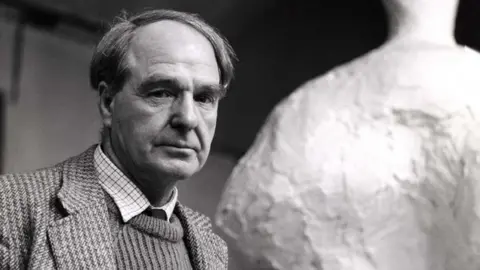Rare Henry Moore sculpture discovered on mantelpiece
 Dreweatts handout
Dreweatts handoutA rare sculpture by pioneering Yorkshire artist Henry Moore has been rediscovered after spending years on a family's mantelpiece.
The work - which is now to be auctioned - was recently authenticated by experts from the Henry Moore Foundation.
The abstract artwork, which represents two figures and is made from lead, will be offered for sale on 16 March.
Auctioneers Dreweatts have valued the rare piece, called Mother and Child, at between £30,000-£50,000.
Dreweatts said the piece was crafted by Henry Moore in 1939-40.
It had been a gift to its original owner, Hubert de Cronin Hastings, who at that time was editor of The Architectural Review - a long-standing international magazine published in London.
In the 1970s, it was passed down to his son, John Hastings, who kept it on his mantelpiece among an eclectic mix of objects until his death in 2019.

Francesca Whitham, a specialist at Dreweatts, described the sculpture as "unique and rare", partly because Moore only briefly worked with lead in the 1930s.
"I was elated, after many months of delays due to Covid restrictions, to finally receive the letter from the foundation authenticating the piece as a genuine Moore," she said.
Mother And Child is believed to have been a preliminary design for one of the artist's famous stringed sculptures.
The Henry Moore Foundation linked the work to a 1939 sketch by Moore from its records, titled Eighteen Ideas For Sculpture.
Henry Moore was born in Castleford, West Yorkshire, in 1898, and later moved to Perry Green, near Much Hadham, in Hertfordshire, where he stayed for the rest of his life.
Renowned for his semi-abstract monumental bronzes, Moore was the first British artist to become globally recognised in his lifetime, according to the foundation.

Follow BBC Yorkshire on Facebook, Twitter and Instagram. Send your story ideas to [email protected].
